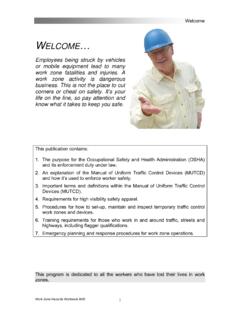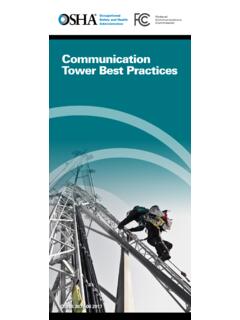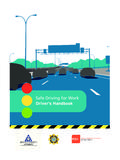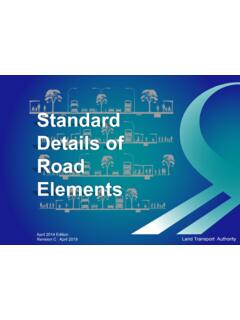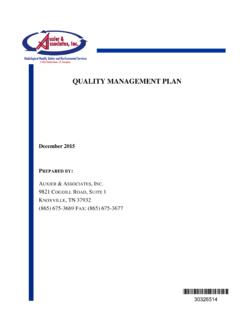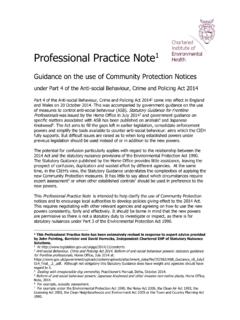Transcription of Use of reasonable force - GOV.UK
1 Use of reasonable force Advice for headteachers, staff and governing bodies July 2013 2 Contents Summary 3 About this departmental advice 3 Expiry or review date 3 Who is this advice for? 3 Key points 3 Who can use reasonable force ? 4 When can reasonable force be used? 4 Schools can use reasonable force to: 5 Schools cannot: 5 Power to search pupils without consent 5 Communicating the school s approach to the use of force 6 Using force 6 Staff training 7 Telling parents when force has been used on their child 7 What happens if a pupil complains when force is used on them? 7 What about other physical contact with pupils? 8 Frequently Asked Questions 9 Further sources of information 10 3 Summary About this departmental advice This is non-statutory advice from the Department for Education. It is intended to provide clarification on the use of force to help school staff feel more confident about using this power when they feel it is necessary and to make clear the responsibilities of headteachers and governing bodies in respect of this power.
2 Expiry or review date This advice will be kept under review and updated as necessary. Who is this advice for? School leaders and school staff in all schools1 in England. Key points School staff have a power to use force and lawful use of the power will provide a defence to any related criminal prosecution or other legal action. Suspension should not be an automatic response when a member of staff has been accused of using excessive force . Senior school leaders should support their staff when they use this power. 1 All schools include Academies, Free Schools, independent schools and all types of maintained schools 4 What is reasonable force ? 1. The term reasonable force covers the broad range of actions used by most teachers at some point in their career that involve a degree of physical contact with pupils.
3 2. force is usually used either to control or restrain. This can range from guiding a pupil to safety by the arm through to more extreme circumstances such as breaking up a fight or where a student needs to be restrained to prevent violence or injury. 3. reasonable in the circumstances means using no more force than is needed. 4. As mentioned above, schools generally use force to control pupils and to restrain them. Control means either passive physical contact, such as standing between pupils or blocking a pupil's path, or active physical contact such as leading a pupil by the arm out of a classroom. 5. Restraint means to hold back physically or to bring a pupil under control. It is typically used in more extreme circumstances, for example when two pupils are fighting and refuse to separate without physical intervention. 6. School staff should always try to avoid acting in a way that might cause injury, but in extreme cases it may not always be possible to avoid injuring the pupil.
4 Who can use reasonable force ? All members of school staff have a legal power to use reasonable force2. This power applies to any member of staff at the school. It can also apply to people whom the headteacher has temporarily put in charge of pupils such as unpaid volunteers or parents accompanying students on a school organised visit. When can reasonable force be used? reasonable force can be used to prevent pupils from hurting themselves or others, from damaging property, or from causing disorder. In a school, force is used for two main purposes to control pupils or to restrain them. The decision on whether or not to physically intervene is down to the professional judgement of the staff member concerned and should always depend on the individual circumstances. 2 Section 93, Education and Inspections Act 2006 5 The following list is not exhaustive but provides some examples of situations where reasonable force can and cannot be used.
5 Schools can use reasonable force to: remove disruptive children from the classroom where they have refused to follow an instruction to do so; prevent a pupil behaving in a way that disrupts a school event or a school trip or visit; prevent a pupil leaving the classroom where allowing the pupil to leave would risk their safety or lead to behaviour that disrupts the behaviour of others; prevent a pupil from attacking a member of staff or another pupil, or to stop a fight in the playground; and restrain a pupil at risk of harming themselves through physical outbursts. Schools cannot: use force as a punishment it is always unlawful to use force as a punishment. Power to search pupils without consent In addition to the general power to use reasonable force described above, headteachers and authorised staff can use such force as is reasonable given the circumstances to conduct a search for the following prohibited items 3: knives and weapons alcohol illegal drugs stolen items tobacco and cigarette papers fireworks pornographic images any article that has been or is likely to be used to commit an offence, cause personal injury or damage to property.
6 force cannot be used to search for items banned under the school rules. 3 Section 550ZB(5) of the Education Act 1996 6 Separate guidance is available on the power to search without consent see the Further sources of information section for a link to this document. Communicating the school s approach to the use of force Every school is required to have a behaviour policy and to make this policy known to staff, parents and pupils. The governing body should notify the headteacher that it expects the school behaviour policy to include the power to use reasonable force . There is no requirement to have a policy on the use of force but it is good practice to set out, in the behaviour policy, the circumstances in which force might be used. For example, it could say that teachers will physically separate pupils found fighting or that if a pupil refuses to leave a room when instructed to do so, they will be physically removed.
7 Any policy on the use of reasonable force should acknowledge their legal duty to make reasonable adjustments for disabled children and children with special educational needs (SEN). Schools do not require parental consent to use force on a student. Schools should not have a no contact policy. There is a real risk that such a policy might place a member of staff in breach of their duty of care towards a pupil, or prevent them taking action needed to prevent a pupil causing harm. By taking steps to ensure that staff, pupils and parents are clear about when force might be used, the school will reduce the likelihood of complaints being made when force has been used properly. Using force A panel of experts4 identified that certain restraint techniques presented an unacceptable risk when used on children and young people. The techniques in question are: the seated double embrace which involves two members of staff forcing a person into a sitting position and leaning them forward, while a third monitors breathing; the double basket-hold which involves holding a person s arms across their chest; and the nose distraction technique which involves a sharp upward jab under the nose.
8 4 Physical Control in Care Medical Panel - 2008 7 Staff training Schools need to take their own decisions about staff training. The headteacher should consider whether members of staff require any additional training to enable them to carry out their responsibilities and should consider the needs of the pupils when doing so. Some local authorities provide advice and guidance to help schools to develop an appropriate training programme. Telling parents when force has been used on their child It is good practice for schools to speak to parents about serious incidents involving the use of force and to consider how best to record such serious incidents. It is up to schools to decide whether it is appropriate to report the use of force to parents5. In deciding what is a serious incident, teachers should use their professional judgement and consider the: pupil s behaviour and level of risk presented at the time of the incident; degree of force used; effect on the pupil or member of staff; and the child s age.
9 What happens if a pupil complains when force is used on them? All complaints about the use of force should be thoroughly, speedily and appropriately investigated. Where a member of staff has acted within the law that is, they have used reasonable force in order to prevent injury, damage to property or disorder this will provide a defence to any criminal prosecution or other civil or public law action. When a complaint is made the onus is on the person making the complaint to prove that his/her allegations are true it is not for the member of staff to show that he/she has acted reasonably. Suspension must not be an automatic response when a member of staff has been accused of using excessive force . Schools should refer to the Dealing with Allegations of Abuse against Teachers and Other Staff guidance (see the Further sources of information section below) where an allegation of using excessive 5 References to parent or parents are to fathers as well as mothers, unless otherwise stated.
10 8 force is made against a teacher. This guidance makes clear that a person must not be suspended automatically, or without careful thought. Schools must consider carefully whether the circumstances of the case warrant a person being suspended until the allegation is resolved or whether alternative arrangements are more appropriate. If a decision is taken to suspend a teacher, the school should ensure that the teacher has access to a named contact who can provide support. Governing bodies should always consider whether a teacher has acted within the law when reaching a decision on whether or not to take disciplinary action against the teacher. As employers, schools and local authorities have a duty of care towards their employees. It is important that schools provide appropriate pastoral care to any member of staff who is subject to a formal allegation following a use of force incident.










